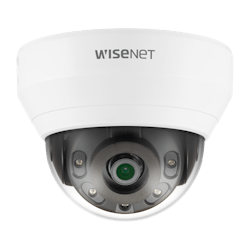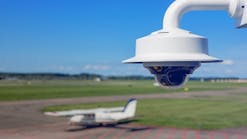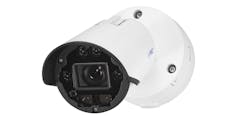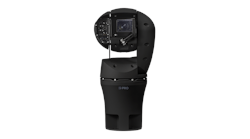A View on Video Surveillance
Similar to locksmithing, video surveillance has experienced something of an identity crisis in recent decades.
Originally, it was called CCTV, a term that reveals how far the technology has evolved. The term “closed-circuit TV” conjures up images of electronic vacuum tubes, which were used in the cameras and TVs.
Since the late 2000s, cathode-ray tubes have been replaced by flat-panel display technologies, such as LCD, plasma and OLED. These panels are more economical to manufacture and operate than are the old tube products. They also are significantly lighter and less bulky, so they can be made in large sizes. (The largest CRT displays were generally 40–45 inches.)
The changeover to flat-panel display technology, along with the use of microprocessors and the adoption of network protocols (Ethernet), Internet Protocol (IP) and wireless networks (Wi-Fi) were revolutionary events in the progress of video and all electronic security.
Let’s take a closer look at what’s trending as well as the state of video surveillance.
Hanwha Techwin’s Vision
Hanwha Techwin America offers video surveillance products, including IP cameras, storage devices and management software. Hanwha’s recently introduced Wisenet line includes 12-megapixel cameras, intelligent video analytics and support for the H.265 video format.
We interviewed Aaron Saks, Hanwha Techwin’s senior product and technical training manager, about today’s video surveillance market
Locksmith Ledger (LL): Video technology has evolved dramatically in a short period. What were the significant changes, and where is video technology today?
Saks: In the past, security installations typically involved a limited number of cameras focused on specific locations. As costs have come down, it’s become easier and more affordable to install more cameras and build more-extensive systems. Resolution has improved steadily, and we’ve had affordable HD [high definition] cameras for many years. Today, you can purchase a 4K- or even 8K-resolution camera, which has 16 times the resolution of HD. These higher resolutions provide more detail when covering wide areas with the capability to zoom in without losing clarity.
Analytics have evolved, too, from detecting simple motion to issuing real-time alerts for loitering and tampering. Cameras can detect audio events, such as gunshots, glass breaks and explosions, and trigger appropriate alarms. Today’s advanced analytics feature machine learning — a subset of AI [artificial intelligence] — which detects objects, such as people, vehicles and license plates, and unique attributes, such as color and type. They even can tell whether you wear a mask properly or too many people are in a given area to comply with social-distancing guidelines.
LL: Is video surveillance a good market for locksmiths and low-voltage professionals?
Saks: Access control has become IP-based over the years, and video just adds another layer for locksmiths and low-voltage professionals. We’re simply running another data connection to an additional location. As long as the infrastructure is there to handle the bandwidth, low-voltage professionals could offer more services over the same network. It also provides a value-add for people wanting to integrate video and access control into a single platform. Being able to have a camera focused on the door you’re about to unlock is valuable. Bookmarking the video at the time the door was opened is a great example of what integration can deliver.
There are many potential opportunities for people who are licensed for low-voltage work, depending on their location. In some states, it’s easy to add video surveillance products that use PoE [Power over Ethernet] cameras, because alarm and burglar licenses might cover these similar types of installations.
LL: Is it safe to say analog is dead and IP has taken over?
Saks: Analog isn’t dead, but the analog cameras we knew from 10 years ago are gone. Hanwha Techwin has HD-over-coaxial products that deliver high resolution with low latency. For someone who is familiar with analog, they can continue to install high-quality systems in the manner to which they’re accustomed. The ability to upgrade an existing system where the coax [cable] and power has been run, for example, to the exterior of a building, and the ability to drop in a replacement camera is important to maintaining customer contracts. This also prevents the customer from having to replace the recording platform and rewire everything, which saves time, labor and money while upgrading feature sets and resolution.
LL: What more should security pros know about license plate capture, video identity verification, remote site management and security management systems?
Saks: These types of systems can be integrated easily. License plate recognition (LPR) might require a special LPR camera depending on the average speed expected from vehicles in the camera’s field of view. Advanced analytics can identify when people are in places they shouldn’t be or tell you a person is at the back door while ignoring vehicle traffic.
With COVID-19, remote management has become a requirement for many organizations. Many employees work off-site, and there are modified staffing levels on-site, forcing security operators to monitor locations differently, with potentially fewer eyes on the ground. Any type of system in use during these challenging times should have some level of cloud management that enables security staff to shift operations easily from on-site to remote without having to do anything else, letting you use what you already have. Cloud services also typically follow a recurring-revenue model, which can be good for everyone, too.
LL: How do smartphones fit into commercial video surveillance?
Saks: Most modern platforms now have an integrated mobile app that should be part of the same system, providing the same feature sets and allowing operators to view live video feeds and search recorded video. Operators should be able to search for motion events or bookmarks and get real-time alerts on a smartphone when an event is triggered. Further integrations support things such as two-way audio for an entrance door and access control. It also is important that installers always ensure that such systems are secure by requiring a cloud infrastructure that adheres to cybersecurity best practices.
LL: What applications are appropriate for multisensor cameras? They obviously resolve the blind-spot issues through the capability to pan, tilt and zoom, but are they cost-effective and worthwhile?
Saks: When multisensor cameras were released, they were expensive specialty products. Today, there’s a wide range of multisensor cameras available, and they have significantly lower costs. In addition to providing multiple views, multisensor cameras require fewer cables and take up fewer ports on the switch. They require less time and materials and less installation labor, and they consume only a single license on most systems. Being able to get exactly the views you want, whether it’s indoor or outdoor, down hallways, across lobbies, corners of buildings or anywhere that you want high camera density, you no longer have to run multiple cameras. They’ve become one of the most common camera types we sell.
View from Optiview
Optiview's portfolio includes video surveillance, access control, networking and infrastructure, and weatherproof enclosures and recorders.
We interviewed Gary Bibeau, Optiview’s director of sales for more.
Locksmith Ledger (LL): What’s been the most significant change in video technology?
Bibeau: The most significant change that I have seen has been the release of analytics on nearly every device. Almost all of Optiview’s video recorders now have analytic capabilities built in, and many of our new cameras include “edge based” analytics. This means the camera can manage the video analytics, and video can record either to an onboard MicroSD card for complete stand-alone recording or to a video recorder in addition to an onboard MicroSD card for redundancy.
LL: Is video surveillance a good market for locksmiths and low-voltage professionals?
Bibeau: Absolutely! Some of Optiview’s largest customers are locksmiths who take advantage not only of our CCTV offering but also our access control equipment. Optiview’s Video Management Software merges video, access control, analytics and reporting into one easy-to-use interface.
LL: Are parking lot cameras a profitable endeavor?
Bibeau: Parking lot cameras are a profitable endeavor when you have the full solution. Optiview created a brand years ago called ArmorLogix. ArmorLogix makes 5052 Marine Grade Aluminum Enclosures. We created these enclosures to hold recorders, network infrastructure and cellular modems to allow us to expand video surveillance coverage to parking lots, remote entrances, gated areas and remote parking areas for large car dealerships.
LL: Does analog video have a future?
Bibeau: This really depends on who you talk to. At Optiview, we still see large volumes of analog being sold. Why is that, you ask? Optiview’s analog cameras are capable of recording up to 4K, 8-megapixel video at up to 15 fps [frames per second], which makes them capable of delivering advanced features, such as panoramic imaging and dewarping. Two of the largest reasons that analog continues to have a place in the market have to do with existing infrastructure and cost. Existing coaxial infrastructure can be used when installing an Optiview DVR, meaning we can run up to 4K, 8-megapixel video on the same cable that the old cameras were installed on, which saves the end user thousands of dollars in installation costs. Analog equipment also is less expensive than IP. Analog is here to stay awhile.
LL: Where does wireless and wired equipment fit into the matrix of product design?
Bibeau: One of the biggest misconceptions that people have about wireless is that it’s 100% wireless. The truth is that you still have to have power, requiring the installer to install wiring. There often are many complications when it comes to accessing traditional wireless cameras because of signal conflicts, a slow network connection and more. Although Optiview doesn’t carry traditional wireless cameras that have built-in antennas, Optiview does have a line of solar-powered platforms that provide true wireless solutions.
LL: What size is the average system, and what integration is most often required?
Bibeau: Optiview has expanded its network of dealers and integrators, and I always find it interesting how many of them settle into a comfort zone. We have some who want to play only in the 8–16-camera market with small daily installs, while others search and complete only large installations — 50-plus cameras at a time — for retail, hospitality, schools and government. All Optiview equipment includes Optiview VMX (Video Management Software), which allows the user to view a single site, multiple recorders at a specific location, multiple sites or even multiple systems over multiple networks stretched across the country or all over the world. Optiview’s largest customers take advantage of the Optiview VMX to view large-scale systems while also managing their access control and video analytics reporting.
LL: What about smartphones? How do they fit into commercial video surveillance?
Bibeau: Everyone is connected nowadays. We have all of the information we want at our fingertips 24/7. If you’re a business owner, on the road or trying to manage multiple sites, the free Optiview app allows you to view a single location or multiple locations simultaneously. We also offer video grouping, which allows the user to group their cash registers, parking lots, lobbies or high-incident areas. This saves the user time and makes it easier for the user to manage. Our latest app allows for two-way audio and access control management, and even allows the user to dewarp 360-degree images live on their phone! It’s very exciting times we live in.
Axis Communications P32 Network Camera Series
Axis Communications launched additions to its P32 Network Camera Series. These streamlined cameras provide cost-efficient installation and are ideal for surveillance in a wide range of locations, including data centers, logistics centers and high-end retail stores.
The varifocal domes deliver excellent image quality indoors or outdoors. Their dust- and vandal-resistant IK10-rated casings protect the cameras from redirection, defocusing and impacts.
The P3247-LV and P3247-LVE have 5-megapixel imagery, and the P3248-LV and P3248-LVE have 4K resolution. Plus, they include Axis Zipstream, which has support for H.264 and H.265 video formats, which reduces bandwidth and storage requirements significantly without compromising image quality.
The cameras feature Lightfinder 2.0 and Forensic WDR to deliver true colors and great detail in challenging light or near darkness. They also include Optimized IR for surveillance in complete darkness, and their motion-adaptive exposure significantly reduces motion blur from approaching or nearby objects. With AXIS Object Analytics, they can detect and classify humans and vehicles. And, through two-way audio and I/O connectivity, it’s possible to add audio analytics and integrate peripheral equipment.
Axis network products provide a variety of built-in cybersecurity features to counter different types of cyberattacks and prevent unauthorized access to your system.
More info: www.axis.com/products
Pelco Sarix Enhanced Cameras
The Sarix series of enhanced cameras is suited for environments that have challenging lighting and harsh environmental conditions. This series is designed to quickly, accurately and reliably extract actionable security information.
Sarix cameras are up to 8 megapixels and have wide dynamic range as well as ultralow-light and image-stabilization capabilities. Because of frame rates up to 120 fps at 1080p, customers can slow scenes of interest and capture detailed images.
The bullet and dome models are IK10 vandal-resistant, which makes them suited to any location where video security equipment could be at risk.
Sarix cameras also come with Pelco Smart Compression and h.265 encoding, which enables lower bit rates without compromising image quality.
The Sarix cameras pair well with Pelco’s Advanced Analytics Suite. This enables customers to focus on situations that require immediate attention for faster response times. The solution also acts as a platform for advanced deep-learning analytics, with superior accuracy in its capability to categorize objects within the scene.
More info: www.pelco.com
Tim O’Leary is an experienced security consultant and a regular contributor to Locksmith Ledger.
Altronix NetWay switches
For decades, Altronix has been a go-to source for power supplies, relays and low-voltage accessories. Altronix provides innovative products for the IP and Power over Ethernet (PoE) infrastructure used in video surveillance as well as electronic access control.
Altronix has released environmentally hardened PoE switches and powered media converters that support the latest 802.3bt PoE devices. These solutions allow multiple high-powered IP devices, such as multisensor cameras, to be deployed in remote locations that have or don’t have local power.
The NetWaySP4BTWP is an outdoor, four-port 802.3bt-compliant switch that has integral power. It’s equipped with two gigabit SFP (fiber) ports, as well as VLAN support.
The NetWaySP4BTWPN is designed for applications where local power isn’t available. It seamlessly accepts power from Hybrid Cable (fiber + copper) to support edge devices.
The NetWaySP4PX is a four-port Ethernet-to-fiber media converter that has an integral power supply or charger for use with Hybrid Cable applications where fiber and power will be delivered long distances when local power isn’t available. This unit is designed for rack-mount installation at the head-end and has four gigabit SFP ports and four 120-watt power terminals.
Altronix’s exclusive LINQ Technology is embedded in NetWay PoE switches to control, monitor and report power or diagnostics or reset devices from virtually anywhere.
More info: www.altronix.com.
Tim O'Leary
Tim O'Leary is a security consultant, trainer and technician who has also been writing articles on all areas of locksmithing & physical security for many years.






